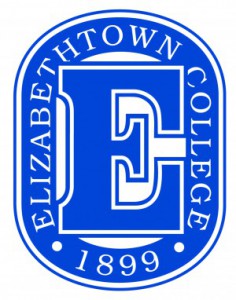 An electronic motor assessment tool (EMAT), which assists in the diagnosis and therapeutic treatment for trauma victims, is one of Elizabethtown College’s first two patents. With fine motor controls and sensors attached to the patient’s wrist and elbow, the device measures lateral and three-dimensional movements.
An electronic motor assessment tool (EMAT), which assists in the diagnosis and therapeutic treatment for trauma victims, is one of Elizabethtown College’s first two patents. With fine motor controls and sensors attached to the patient’s wrist and elbow, the device measures lateral and three-dimensional movements.
The inventors, Professor of Engineering and Physics Dr. Kurt DeGoede and Associate Professor of Occupational Therapy Dr. Daniel Panchik, also designed the second patent, an electronic hand assessment tool, called EHAT. This tool also is used to assess and develop a patient’s fine motor control. The project, the result of an interdisciplinary joint venture and several years of development, included collaboration with a Pinnacle Health physician.
Elizabethtown College’s Office of Sponsored Research and Programs (OSRP) processed the first two College patents, which are currently at the provisional level, being reviewed by attorneys for upgrade to full patent status.
OSRP, created in July 2012, was created as an element of the College’s 2012 Strategic Plan. Under the direction of Dr. Richard Basom Jr., executive director of sponsored research and programs, and assisted by Sharron Farish, the office follows “the mission to promote, facilitate and oversee external sponsorship of research and program at Elizabethtown College.” OSRP also works to assist in the commercialization of the College’s intellectual property – exclusive rights for creations of the mind.
Once intellectual property is disclosed to the OSRP and the commercial potential anticipated, the College provides funding for the patent process and secures the project. Granted licenses or other commercialization ventures can result in new jobs, royalties or other generated revenue. This financial assistance is provided to the College and the inventors, generating economic development for the community.
Most recently, Dr. Sarah Atwood and DeGoede, assisted by OSRP, secured funding from external sponsors and were awarded a five-year grant. The National Science Foundation conferred on the duo $560,000 in July 2013 to provide scholarships and retention support for women in engineering.
When seeking external sponsors, inventors submit, on average, 15 to 20 grant applications and other proposals. These applications are submitted to foundations, companies and government agencies requesting support for research and programs at the College.
Basom and the faculty or staff member(s) work together to write and submit grant applications and ensure compliance with all sponsor requirements. OSRP facilitates closing the deal, including federal and state compliance. “It can take months to get a grant approved. Sometimes it takes a full year,” said Basom.
The office provides grant workshops to faculty members, students and staff members. New faculty members, unfamiliar with the grant application process, are given the opportunity to speak with current faculty colleagues, who have previous research experience. “It’s good to hear from your peers, especially those with previous experience and success,” Basom said. “I think the grant workshops are critical to building the College’s research capacity and success rate.”
I think the grant workshops are critical to building the College’s research capacity and success rate.”
Last summer, OSRP began SCARP, a new student research program. SCARP, also known as Scholarship, Creative Arts, and Research Projects, is a summer program in which students and faculty members are granted stipends, and students are provided room and board. This past summer, 22 students completed independent projects. “While summer research has been going on at the College for many years, this is the first year of the SCARP program,” Basom said. “The program was very successful … It really came together.”
Associate Professor of Biology Dr. Diane Bridge and students studied Hydras this summer with grant money from the National Institutes of Health and financial support from the College. At the end of the summer, the students presented their research at mini conferences on campus.
The new SCARP program implements the strategic plan’s goal to offer students real-world learning opportunities. “Some students said this research could not have been done without SCARP; it couldn’t be done in the classroom due to the time constraints,” said Farish, OSRP administrative assistant.
Currently, six faculty applications have been sent out to various funding agencies for consideration. Several more are under development. In the future, ORSP hopes to secure $1 million of external funding per year. However, Basom and Farish understand that accomplishing that goal will take several years of building the office’s reputation and expanding its capacity of work.
In the future, OSRP hopes to experience continued growth in both external funding and commercialization. “In five years, we hope to have two or three more faculty members focused on research that can result in intellectual property,” said Basom.

